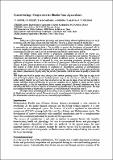Por favor, use este identificador para citar o enlazar a este item:
http://hdl.handle.net/10261/313472COMPARTIR / EXPORTAR:
 SHARE
BASE SHARE
BASE
|
|
| Visualizar otros formatos: MARC | Dublin Core | RDF | ORE | MODS | METS | DIDL | DATACITE | |

| Título: | Gamete biology: Perspectives for Bluefin Tuna Aquaculture |
Autor: | Fauvel, Christian; Suquet, Marc; de-la-Gándara, Fernando; Medina, A.; Abascal, Francisco Javier; Mylonas, C.C. | Palabras clave: | Acuicultura Thunnus thynnus Centro Oceanográfico de Murcia Bluefin tuna gamete biology Reproduction Spermatozoa oocyte |
Fecha de publicación: | nov-2004 | Citación: | The 21st Century COE International Symposium. (10/11/2004 - 11/11/2004. Osaka (Japón)). 2004. . En: , . | Resumen: | Taking care of fish reproductive physiology and gamete biology allowed significant progresses in fry production control for many commercially interesting fish. Can it be a similar situation for bluefin tuna? Fish gamete production results from long processes controlled mainly by climatic conditions, mediated by neuroendocrine and endocrine factors. The possibility to monitor the development of germinal cells by successive sampling in individual fish which easily breed in captivity, has allowed learning about the sequences of gametogenesis and their control, as well as important characteristics of fish gamete biology. The female ovarian cycle involves a progressive accumulation of yolk in the oocytes (i.e., vitellogenesis), followed by cytoplasmic and nuclear events related to maturation and ovulation. The phases of vitellogenesis and maturation are of different duration in different species. In captive fish the endocrine regulation of reproduction may be disrupted by stress, thus preventing spontaneous spawning, while the application of exogenous hormones at the conclusion of gametogenesis allowed production of good quality gametes. In males, gamete production is not continuous as in mammals. Spermatozoa are produced after a cycle that includes a resting period, followed by continuous or discontinuous sequences of spermatogenesis (spermatogenesis sensu stricto, spermiogenesis and spermiation). The discontinuity of fish sperm production may induce a phenomenon of ageing along the period of spermiation, which decreases the quality of semen with time. Wild bluefin tuna breed in specific areas during a short summer spawning season. When kept in cages in the area of Cartagena (Spain), they present developed gamete stages at the same time as wild fish, but, until now, neither mating behavior nor eggs have been observed as was the case in Japan. It has not been possible to monitor individual gonad recrudescence by successive sampling, due to inability to handle the fish without causing mortality, so that the reproduction failure remains unexplained. Hormonal stimulation may be an interesting alternative but its use requires an assessment of gonadal stage to be performed properly. The high post-handling mortality of bluefin tuna in captivity is a real bottleneck for reproduction control. The improvement of handling and the use of less stress-susceptible individuals may be a major progress for bluefin tuna reproduction control. The occurrence of a second generation of juveniles in Japan, subjected to first domestication selection may provide very interesting experimental fish. | URI: | http://hdl.handle.net/10261/313472 |
| Aparece en las colecciones: | (IEO) Comunicaciones congresos |
Ficheros en este ítem:
| Fichero | Descripción | Tamaño | Formato | |
|---|---|---|---|---|
| 4245(1).pdf | texto comunicación | 121,43 kB | Adobe PDF |  Visualizar/Abrir |
| 4245.pdf | presentación | 7,27 MB | Adobe PDF |  Visualizar/Abrir |
CORE Recommender
Este item está licenciado bajo una Licencia Creative Commons

